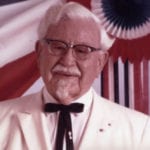 History
History  History
History  Movies and TV
Movies and TV 10 Practical Movie Monsters Remade with CGI
 Politics
Politics 10 U.S. Presidents Who Cheated on Their Wives
 Humans
Humans The 20th Century’s 10 Most Famous Centenarians
 History
History 10 Influencers Who Lived Centuries before Social Media
 Miscellaneous
Miscellaneous 10 Ancient Etiquette Rules You Never Knew Existed
 Our World
Our World Planet Earth’s 10 Most Hardcore Natural Creations
 Movies and TV
Movies and TV 10 Times Twin Movies Competed with Each Other
 The Arts
The Arts 10 Masterpieces Plucked from the Artist’s Subconscious
 Crime
Crime 10 Fascinating Facts about Rikers Island
 History
History 10 Shocking Roman Assassinations That Inspired the Ides of March
 Movies and TV
Movies and TV 10 Practical Movie Monsters Remade with CGI
 Politics
Politics 10 U.S. Presidents Who Cheated on Their Wives
Who's Behind Listverse?

Jamie Frater
Head Editor
Jamie founded Listverse due to an insatiable desire to share fascinating, obscure, and bizarre facts. He has been a guest speaker on numerous national radio and television stations and is a five time published author.
More About Us Humans
Humans The 20th Century’s 10 Most Famous Centenarians
 History
History 10 Influencers Who Lived Centuries before Social Media
 Miscellaneous
Miscellaneous 10 Ancient Etiquette Rules You Never Knew Existed
 Our World
Our World Planet Earth’s 10 Most Hardcore Natural Creations
 Movies and TV
Movies and TV 10 Times Twin Movies Competed with Each Other
 The Arts
The Arts 10 Masterpieces Plucked from the Artist’s Subconscious
 Crime
Crime 10 Fascinating Facts about Rikers Island
10 Festive Facts about ‘A Christmas Carol’ and Its Adaptations
Charles Dickens’s A Christmas Carol (1843) is one of the most iconic Christmas stories. The novella is about Ebenezer Scrooge, a miser who becomes kinder after being visited by the ghosts of Christmas Past, Present, and Yet to Come. The story has been adapted and riffed on hundreds of times over the years and has become a familiar part of the festive season. Here are 10 interesting facts about the novella and its many adaptations.
Related: Top 10 Behind-the-Scenes Facts about Popular Christmas Movies
10 The Real Meaning of Humbug
Although Dickens didn’t invent the word humbug—it first appeared in print in a 1751 issue of The Student, or the Oxford and Cambridge Monthly Miscellany—having Scrooge utter “Bah! Humbug!” at the mention of Christmas did popularize it. These days, it’s common to think that the word is just an expression of dislike, in Scrooge’s case, a dislike of Christmas. But Scrooge was actually using it to express his belief that Christmas was a hoax. Merriam-Webster defines a humbug as “something designed to deceive and mislead.”
When Scrooge’s nephew, Fred, presses him to explain his use of humbug, he responds, “What reason have you to be merry? You’re poor enough.” Scrooge believes that Christmas tricks people into being happy and is used to swindle money out of the wealthy.[1]
9 Scrooge Doesn’t Actually Visit Bob Cratchit on Christmas Day
In most adaptations of A Christmas Carol, the narrative ends with a reformed Scrooge spending Christmas with the Cratchit family, but this sweet scene isn’t in the original story. In Dickens’s tale, Scrooge has the largest turkey bought for the family, but he doesn’t deliver it himself; instead, he declares, “I’ll send it to Bob Cratchit’s… He shan’t know who sends it.”
Scrooge goes to church and then to Fred’s house to celebrate, but he doesn’t see Bob until the next day. His employee comes to work slightly late, and Scrooge, playing a joke on him, acts as though he is angry, stating, “I am not going to stand this sort of thing any longer,” before revealing, “Therefore I am about to raise your salary!”[2]
8 Bill Murray Ad-Libbed a Lot of Scrooged (1988)
Bill Murray is known for his comedic improvisational skills, which led to Scrooged director Richard Donner describing working with him as “like standing on 42nd Street and Broadway, and the lights are out, and you’re the traffic cop.” Murray had his own complaints, telling Roger Ebert in a 1990 interview that he clashed with Donner “every single minute of the day” and that “he kept telling me to do things louder, louder, louder. I think he was deaf.”
Despite the on-set tension, some of the improvised moments have become iconic. In Mr. Mike: The Life and Work of Michael O’Donoghue (1998), a book about one of the film’s writers, Dennis Perrin notes that Murray improvised much of his heartfelt speech at the movie’s climax. He also went off-script when everyone sings “Put a Little Love in Your Heart” to close the film, quoting “Feed me, Seymour! Feed me!” from Little Shop of Horrors (1986), which he had a cameo role in. Another unscripted moment is when he slips and falls over after splashing the waiter with water.[3]
7 The Name Scrooge Quickly Came to Mean Miser
A Christmas Carol was published in 1843, and by the early 1900s, the name Scrooge had become synonymous with miser and cheapskate. Dickens likely based the iconic surname on the word scrouge, which means “to squeeze, press, crowd (someone).” Dickens nods to this meaning in his description of Scrooge as “a squeezing, wrenching, grasping, scarping, clutching, covetous old sinner!”
Scrooge’s first name, Ebenezer, also holds a deeper meaning. Ebenezer is a Hebrew name meaning “stone of help.” Scrooge’s stoniness is pointed out directly after he is described as a squeezing sinner when he is said to be “hard and sharp as flint from which no steel had ever struck out a generous fire.”[4]
6 A Christmas Carol Popularized Saying “Merry Christmas”
Many Christmas traditions have their roots in the Victorian period, including decorating Christmas trees, sending festive cards, and spending time with family. A Christmas Carol was written when these traditions were starting to take hold, and the novel’s popularity helped to spread them even faster. One thing in particular that Dickens popularized was saying “Merry Christmas” instead of “Happy Christmas.”
The first recorded use of this phrase is from a 1534 letter written by Bishop John Fisher to Thomas Cromwell: “And thus our Lord send yow a mery Christenmas, and a comfortable, to yowr heart desyer.” The words “happy” and “merry” were both used in the phrase for many years, but that all changed after A Christmas Carol. Dickens had a preference for “merry,” with “Merry Christmas” being peppered throughout the novella and “Happy Christmas” not making a single appearance.[5]
5 More Than One Song Cut from The Muppet Christmas Carol (1992)
Fans of The Muppet Christmas Carol will know that the song “When Love Is Gone,” an emotional ballad between Scrooge (Michael Caine) and his lost love Belle (Meredith Braun), was cut from the theatrical release. Brian Henson, the film’s director and son of Muppets creator Jim Henson, told Entertainment Weekly that after test screenings, Jeffrey Katzenberg, chairman of Walt Disney Studios, said to him, “Do you see how antsy those kids are getting? It’s just a little too adult-emotional for little kids to stay connected.” Henson agreed to ax it but admitted that “I obviously preferred having the song in.”
Henson later decided to restore the song, but the original negative of the scene had been lost (although a poorer-quality version was available). The missing film was finally found in 2020, and the extended cut was available to watch on Disney+ in 2022.
“When Love Is Gone” isn’t the only song that was cut from the theatrical release, though. Bunsen and Beaker originally sang “Room in Your Heart” when asking Scrooge for donations for the poor, while Sam Eagle sang “Chairman of the Board” to child-aged Scrooge. Both songs were recorded and then cut before filming began, but they can be found on the soundtrack.[6]
4 A Christmas Carol Has Some Strange Adaptations
A Christmas Carol is one of the most adapted literary works ever, with the first three stage productions opening on February 5, 1844, just weeks after the book’s release. The only one sanctioned by Dickens was Edward Stirling’s A Christmas Carol: or, Past, Present, and Future at the Adelphi Theatre. The other two were C.Z. Barnett’s A Christmas Carol: or, the Miser’s Warning at the Royal Surrey Theatre and Charles Webb’s Scrooge, A Miser’s Dream at Sadler’s Wells. Since then, there have been hundreds of adaptations, a few of which are a little strange.
A Klingon Christmas Carol hit the stage in Minneapolis in 2007 and has proved popular enough to be staged many times since. Scrooge is renamed SQuja’, and rather than lacking charitable Christmas spirit, he’s a coward who learns how to be honorable. Other peculiar versions include Marcel Marceau’s 1973 mimed version and the various zombie adaptations. There’s Adam Roberts’s 2009 book I Am Scrooge: A Zombie Story for Christmas, Marvel comics’ Zombies Christmas Carol, and the 2015 short film A Christmas Carol + Zombies. In 2016, Heath Waterman released a mashup video on YouTube that tells the entire story in snippets taken from 400 different adaptations.[7]
3 Dickens Also Created His Own Adaptation
On December 27, 1853, Dickens gave a reading of A Christmas Carol at Birmingham Town Hall. In keeping with the theme of the story, the proceeds of the show—which lasted around three hours—went to charity. The Birmingham Journal reported that “Mr. Dickens did not only read the story, he acted it too. Everybody was charmed by the way in which the story was told. How Mr. Dickens twirled his moustache, or played with his paper knife, or laid down his book, or lent forward confidentially…”
Dickens went on to perform the story 127 times, and it proved a lucrative way to make money in addition to publishing books. He created a special prompt book for the performances and also streamlined the story to shorten the runtime. Mark Twain attended one of Dickens’s New York performances in January 1868 but found his reading of David Copperfield (1849-50) to be lackluster. “He is a bad reader in one sense,” Twain wrote, “because he does not enunciate his words sharply and distinctly.” As well as being Dickens’s first public reading, A Christmas Carol was also his last, being performed at St. James’ Hall in Piccadilly a few months before his death in 1870.[8]
2 A Christmas Carol Was Written as a Push for Social Reform
When Dickens was just 12, his family experienced financial hardship, and he was pulled out of school to work at a shoe-blacking factory. Dickens was financially successful as an adult, but he remained passionate about changing working conditions for the poor. At the start of 1843, he read a government report titled “Second Report of the Children’s Employment Commission,” which outlined the awful working conditions suffered by children.
Dickens decided to write a public appeal pamphlet but then had a better idea, explaining in a letter to Southwood Smith, one of the report’s commissioners, that “you will certainly feel that a Sledge hammer has come down with twenty times the force—twenty thousand times the force—I could exert by following out my first idea.”
His new idea was to write a fictional story to play on people’s emotions, and the result, A Christmas Carol, was completed in time for Christmas. The novella was based on a short story, “The Story of the Goblins Who Stole A Sexton,” which Dickens had included in The Pickwick Papers (1836-37). The story is about a miser called Gabriel Grub, who is visited by goblins on Christmas Eve and is shown his past and future in an attempt to change his ways.[9]
1 Tiny Tim’s Fate Was Unknown in the Original Manuscript
In the original manuscript, Dickens failed to mention whether Scrooge’s change of heart saved Tiny Tim. It reads: “Scrooge was better than his word. He did it all, and infinitely more. He became as good a friend…” Dickens realized that readers would want to know Tim’s fate, so after “infinitely more,” he added, “and to Tiny Tim, who did NOT die, he was a second father.”
Tiny Tim was also originally called Little Fred, but that name was given to Scrooge’s nephew. Although Tim ended up living, his real-life inspiration sadly did not. Dickens likely based the character on his own disabled and sickly nephew, Harry Burnett, who died when he was just nine.[10]








